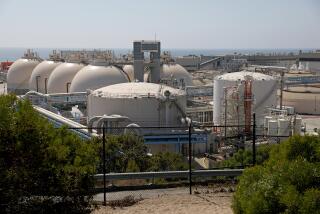Clean Water Cost Put at $83.5 Billion : EPA Says Two-Thirds of Treatment Plants Have Problems
- Share via
WASHINGTON — Highlighting the enormity of an unmet need, the Environmental Protection Agency Tuesday revised its estimated cost of upgrading the nation’s sewage treatment facilities to meet federal standards for water quality and public health to $83.5 billion.
The new figure is a 4% real increase over a previous assessment in 1987, suggesting that the nation has failed to gain ground in combatting water pollution.
More than two-thirds of the nation’s 15,600 waste-water treatment plants now have “documented water quality or public health problems,” the agency said in a report to Congress assessing the nation’s compliance with standards set under the 1972 Clean Water Act.
Cooperation Urged
After noting that the cost of improvements would consume all of the EPA’s current $4.9-billion annual budget for the next 17 years, new EPA Administrator William K. Reilly declared: “We must think cooperatively about how we are going to solve waste-water treatment problems.”
But representatives of municipal water treatment agencies charged that the new Administration has not cooperated with them so far, noting that its $1.2-billion budget request for water cleanup funds is only half that authorized by Congress.
“What it means is that there isn’t going to be enough money,” said Eric Sapirstein, a lobbyist for the California Assn. of Sanitation Agencies. “If you’re low on the priority list and there isn’t enough money to go around, you ain’t going to get funded.”
Sewage treatment modernization costs in California were estimated at $5.3 billion, third highest in the nation behind New York and Massachusetts.
The city of Los Angeles has committed itself to a $3-billion modernization program, but Los Angeles County sanitation districts are still seeking a waiver that would free them from costly renovation to meet federal sewage treatment standards.
Shifted the Burden
State officials’ concerns reflect a new anxiety in the wake of passage two years ago of the Water Quality Act, which shifted the burden for construction of waste-water treatment facilities from the federal government to state and local authorities.
That legislation, passed with the support of the current critics, set out a plan calling for federal construction grants to be phased out at the end of this year and to be replaced by contributions to a State Revolving Loan Funds program.
But, because the Reagan and now the Bush Administration requested less financing than Congress envisioned, state officials and environmentalists are warning that the nation’s quest for clean water could be left severely underfinanced.
“There are going to be some serious water quality problems coming down the road,” said Linda Eichmiller, deputy director of the Assn. of State and Interstate Water Pollution Control Administrators. “That’s the risk here. That’s what’s at stake.”
EPA Administrator Reilly, noting that the 4% increase in the estimated cost of cleaning up waste water is small in comparison to previous fluctuations in estimates, said in a statement: “The good news from the survey is that our need for new or improved waste-water treatement facilities appears to be leveling off, and we now know the scope of the need.”
But Reilly pointed out that the survey “found significant unmet needs, with a large price tag.”
Revised modernization plans for some waste treatment plants and recently identified needs for other facilities account for the bulk of the increase, the agency reported. It said that the greatest needs are concentrated in highly populated states such as California, New York, Florida and Texas.
Environmentalists Scoff
However, a number of environmentalists scoffed at Reilly’s contention that an increase in estimated clean water costs could be viewed as “good news.” They argued that the revised figure calls attention to the inadequacy of the Administration’s current budget request and to the magnitude of the task remaining.
“Everyone may have assumed we were well on the way to clean water,” said Eric Draper, director of the Clean Water Action Project. “This should cause everybody to sit up and take notice and say: ‘What is going on here?’ ”
More to Read
Sign up for Essential California
The most important California stories and recommendations in your inbox every morning.
You may occasionally receive promotional content from the Los Angeles Times.










